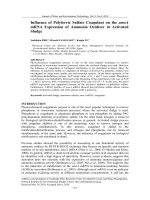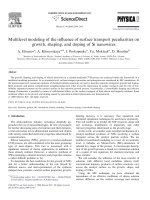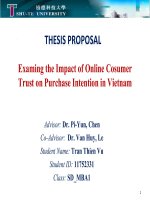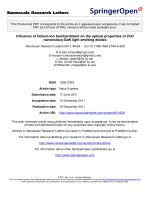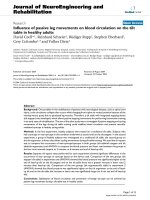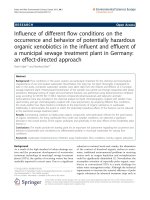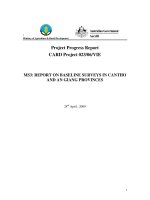The influence of practicing spiritual tourism on the environment in Chau Doc – An Giang – Viet Nam
Bạn đang xem bản rút gọn của tài liệu. Xem và tải ngay bản đầy đủ của tài liệu tại đây (1.58 MB, 8 trang )
Science & Technology Development Journal – Social Sciences & Humanities, 3(1):47- 54
Research Article
The influence of practicing spiritual tourism on the environment in
Chau Doc – An Giang – Viet Nam
Ta Duy Linh, Duong Duc Minh*
ABSTRACT
Chau Doc is a city of An Giang province in Mekong delta of Vietnam. This city has Sam Mountain with cultural and spiritual values. One of the highlights of the local spiritual culture is Ba Chua
Xu (Lady Territory) shrine. Every year, this spot attracts between 3 and 5 million visitors. With a
great number of tourists, the practicing of spiritual tourism has had an impact on the natural and
cultural-social environment. The influence of stakeholders on the environment (nature and humanity) through the enjoyment and provision of tourism services. Stakeholders have involved in tourism
activities in Chau Doc include: local authorities, service providers (food and beverage, accommodation, transportation,...) and tourists. The practice of spiritual tourism is different from other types
of tourism. Spiritual need has overwhelmed need to enjoy tourist services. With the expectation
of improving economic benefits for the locality, tourism services are increasingly invested and supplemented. When economic interests are concerned, the issues of preserving natural values and
cultural-social are limited, creating threat that could hurt the environment in Chau Doc. Therefore,
the exploitation and development of spiritual tourism creates certain influence on the local environment. The study of the effects of spiritual tourism practice is necessary in the present context.
Through field surveys, in-depth interviews with stakeholders and observations in local spiritual culture festivals from September 2016 to June 2018, this article describes and analyzes characteristics
of practicing spiritual tourism in Chau Doc. Since then, the authors find out the influence of practicing spiritual tourism on natural and cultural - social environment of locality. At the same time,
the authors provide some suggestions for exploiting spiritual tourism in Chau Doc.
Key words: practicing spiritual tourism, impact on environment, Chau Doc – An Giang – Viet Nam
INTRODUCTION
The University of Social Sciences and
Humanities, VNU-HCM
Correspondence
Duong Duc Minh, Email:
History
• Received: 30-11-12018
• Accepted: 04-4-2019
• Published: 28-6-2019
DOI :
/>
Copyright
© VNU-HCM Press. This is an openaccess article distributed under the
terms of the Creative Commons
Attribution 4.0 International license.
Methodology
Through the process of collecting secondary materials
and field surveys in Chau Doc - An Giang from from
May 2016 to January 2018, we use research methods: in-depth interviews (tourists, local community,
representatives of the governmental authorities on
tourism management, representatives of travel companies) in Chau Doc - An Giang. Then, we integrate
the interview results into analytical content of the article.
Researching approach
In this paper, we analyse the influence of practicing
spiritual tourism on the environment from anthropological perspective with sustainable tourism development thinking.
In 1950, the concept of development was used to look
at comparisons between developed and developing
countries 1 . At early stage, development is almost considered economic growth. In fact, economic growth
is not only the result that can lead to good quality
of life. Apart from economic growth, other indicators of environment, society and culture must be ensured. From that, the movement of economic development associated with environmental protection has
been formed. At the same time, the issue of balancing economic development with culture and society
is concerned and complementary. This is the premise
to Brundtland report was born in 1987 2 . This report
introduces the concept of sustainable development in
a formal way.
Sustainable development has become a global discourse. Because the orientation of sustainable development is to justify and overcome the limitations of
development that humanity is confronted with. Sustainable development is a shift in approach that emphasizes harmony rather than conflict. Sustainable
development towards the balance of pillars including
economy, natural environment, society, culture and
management of government.
The anthropologist, as a researcher, will have the
strength to analyze the discourses of sustainable development from “poststructuralism”; identify the capacity of local communities (especially ethnic mi-
Cite this article : Linh T D, Minh D D. The influence of practicing spiritual tourism on the environment
in Chau Doc – An Giang – Viet Nam. Sci. Tech. Dev. J. - Soc. Sci. Hum.; 3(1):47-54.
47
Science & Technology Development Journal – Social Sciences & Humanities, 3(1):47-54
nority groups) when approaching and implementing
policies; analyze changes and make forecasts that hurt
the local community; forecast conflicts of rights and
interests of stakeholders; recommend policies that are
feasible and suitable for sustainable livelihoods towards poverty reduction, gender equality, etc.
In the field of tourism, the concept of sustainable
tourism appears on the basis of improving and upgrading the concept of “soft tourism” in the 1990s 3 .
Since then, this concept has been launched by many
organizations and individuals, and is actually gaining
widespread attention over the word.
According to World Tourism Organization sustainable tourism is: “Tourism that takes full account of its
current and future economic, social and environmental
impacts, addressing the needs of visitors, the industry,
the environment and host communities”a .
Thus, sustainable tourism should:
1. Make optimal use of environmental resources
that constitute a key element in tourism development, maintaining essential ecological processes
and helping to conserve natural heritage and biodiversity.
2. Respect the socio-cultural authenticity of host
communities, conserve their built and living cultural heritage and traditional values, and contribute to inter-cultural understanding and tolerance.
3. Ensure viable, long-term economic operations,
providing socio-economic benefits to all stakeholders that are fairly distributed, including stable employment and income-earning opportunities and social services to host communities, and
contributing to poverty alleviation 4 .
The discourse of sustainable tourism development has
a great influence on the planning, organization and
management of tourism in Vietnam. The Politburou’s
Resolution 08-NQ/TW on developing tourism has
been concluded: “sustainable tourism development;
preserving and promoting the cultural heritage and traditional values; protecting natural environment, resolving the problem of labour, employment and social security” 5 .
From the anthropological approach, this paper focuses on analysing the discourse of sustainable
tourism development; attitude, behaviour and practice of stakeholders in the sustainable tourism development strategy in Vietnam with typical example is
Chau Doc – An Giang.
a
48
(June 22, 2018)
RESULTS AND DISCUSSION
Overview of Chau Doc — An Giang
In the painting of An Giang tourism, Chau Doc is seen
as a prominent tourist center of the province. The
key of tourism development in Chau Doc is historical relics of Sam Mountain.
In the development strategy of Vietnam’s tourism until 2020 and vision to 2030, the Ministry of Culture,
Sports and Tourism has oriented development of The
System Mausoleum Temple Sam Mountain become
the national tourism site.
Especially, the place that attracts more tourists is Ba
Chua Xu shrine (Lady Territory shrine) - dubbed
“chicken that lays golden eggs” for An Giang tourism.
Sam Mountain with a total area of 2 hectares, where
each year attracts about 5,300,000 tourists and pilgrim
visitsb . Visitors and sources of revenue in 2014, 2015
as follows: 2014: 4,200,000 passengers, collecting entrance fees was 19.96 billion VND; 2015: 4,274,800
passengers, collecting entrance fees is 30,411 billion
VND 6 .
The peak season of spiritual
tourism in Sam Mountain takes
place from after the Tet lasts until
the end of April lunar calendar.
Since this is the season to visit
Ba Chua Xu shrine.
About
3.000.000 – 4,000,000 tourists
come to visit Sam Mountain
during this time. Ba Chua Xu
shrine is a tourist attraction
featured psychic in the South of
Vietnam. On peak days, Sam
Mountain can welcome up to
72,000 passengers” (Results of
interviews representatives of
the Manager of Toursim Office,
Department of Culture, Sports
and Tourism of An Giang on at
8:30 on 09 Jun 2018)
Therefore, the capacity on peak days in Sam Mountain
is 72,000 passengers / 2 hectares (72,000 passengers /
20,000 m2 ) that means approximately 3.6 passengers
/ m2 . This figure has exceeded the capacity of tourist
standard. Thereby can imagine Sam Mountain relics
under intense pressure of visitors at this time. This
research should be considered directly the administration to reduce pressures and harms the monument
b
Results of interviews representatives of the Department of Culture, Sports and Tourism of An Giang on at 8:30 on January 2018
Science & Technology Development Journal – Social Sciences & Humanities, 3(1):47-54
system towards conservation and spiritual nature. At
present, Ba Chua Xu shrine is in the peak season, the
phenomenon of unsettled purchases, theft, loss of security and order — beauty has seriously affected the
image of tourism, land and local people in the eyes of
visitors. Capacity of Sam Mountain in the peak season can be imaged by follow Figure 1.
Besides, although the visitors have positive and encouraging signs in terms of increasing quantity, but
the behavior of tourism services consumption (accommodation, food, tours of nearby attractions) less
rich and varied that leads to payment for spiritual
tourism when visit Sam mountains is not highc . As
tourist coming to Sam Mountain is mainly due to the
spiritual needs of visitors, however, revenues from
tourists are incommensurate. One of the reasons for
the above situation is the power of supply activities
and tourism services to visitors coming to the mountain spirit Sam in particular and An Giang in general
still have not yet to use, combine to exploit the other
tourist resources available in local communities this
spiritual tourism sites.
Analysing the impact of tourism development to environment in Chau Doc — An Giang
Firstly, we analyze the first pillar of sustainable
tourism development at Chau Doc — the local policy. We chose two document to debate are Decision
approving the master plan for tourism development of
An Giang province from 2014 to 2020 and vision to
2030d (document 1) and Construction plan and process to upgrade Sam Mountain to become the national
destinatione (document 2). In particular, document 1
mentions “tourism development in An Giang towards
sustainable, professional and modern” 7 . Document 2
mentions “tourism development is closely linked to the
development of trade and preservation of national culture, identity in order to actively contribute to the sustainable economic development of the locality” 8 . Two
documents clearly emphasize the objective of sustainable tourism development. Thus, the discourse on
sustainable tourism development has a great influence
on the orientation of tourism development in An Giang in general and Chau Doc in particular.
Next, we analyze the actual development of tourism in
Chau Doc. Sam mountain is the core of tourism development in Chau Doc. The parties involved in the
c
Depth interview with Leaders of the Department of Culture,
Sports and Tourism An Giang on 9 June 2016
d
By The People’s Committee of An Giang Province issued in 2014
e
By The Management Board of Sam Mountain cultural relics and
tourism issued in 2014
exploitation and the development of spiritual tourism
at Sam mountain culture space including: tourists;
the State management agencies on tourism; the management board of spiritual culture — religious relics;
service facilities to serve the needs of the tourists
(transportation, restaurants, inns, hotels and establishments providing offerings, souvenirs,...) and the
locals (hawkers, motorbike taxi, “service brokers”,...).
Tourists are required to pay for the services performed
during the spiritual tourism activities, from transportation; storage; food and drink; worship, offerings
and other services. The remaining parties involved are
the persons receiving the economic benefits from the
tourism. With the exploitation and development, the
tourism seems to facing overload which reduces the
spiritual and cultural values and creates a negative to
the tourists. Service for tourist is illustrated by Figure 2.
Identifying the available potential of this travel complex, the local government has made plans to exploit
the elements of culture, arts, spirit to serve tourism in
the overall travel activities of the province. An Giang
Province has organized the review, statistics to manage 115 temples, pagodas, hermitages. At the same
time, it calls for investment in the key projects such as
moving the current gardens in Sam Mountain to the
new location and adding new items to build a complex
(a size of 9 ha, total investment of 139 billion VND);
Truong Gia Mo lake-bed tourist area (a size of 10 ha,
total investment of 53 billion VND); Sam Mountain
entertainment complex (a size of 70 ha); Chau Doc
City entertainment and resort area (a size of 70 ha);
3- 4-star floating hotel on Chau Doc River (size of
0.8 ha, total investment of 53 billion VND), and Sam
Mountain Cultural Park. At this park, an 81-meter
statue of Buddha Shakyamuni basing on Sam Mountain would be built with a cost of 255 billion VND (the
groundbreaking ceremony was on 05 March 2015)
which is expected to form the key spiritual destination of Vietnam. (Result of interview with The Management Board of Sam Mountain cultural relics and
tourism in June 2018)
In the process of building new architectural works for
tourism development in the mountain Sam, there appears some constructions which are not in accordance
with the traditional cultural values of the locality. In
particular, the construction of a new statue of Ba Chua
Xu in early 2018. Soon after, this statue was asked to
remove. The new statue of Ba Chua Xu is illustrated
by Figure 3.
Therefore, spiritual values are the important cultural
resources which have been contributing to the economic development of tourism in Nui Sam relics
49
Science & Technology Development Journal – Social Sciences & Humanities, 3(1):47-54
Figure 1: Capacity of Sam Mountain in the peak season. Source: Ta Duy Linh - Duong Duc Minh, 2018
Figure 2: Service in Chau Doc — An Giang. Source: Duong Duc Minh, 2016 – 2018
(Chau Doc) and continue to be promoted. In the exploitation and development of tourism in this spiritual tourism today, although the local authority has
made certain efforts, it still has barriers profoundly affecting the goals of stable tourism development of the
locality. Because the economic values have emerged
but the cultural and sociable values tend to be affected.
The focus of Sam mountain complex in the exploitation and development of tourism is a tourism complex
of Ba Chua Xu shrine - Thay Tay An Pagoda - Thoai
Ngoc Hau Tomb. Bustling scene of the people visiting
these worship places is common here. Especially in
the high season, from 23 to 27 April according to the
lunar calendar when people come here to worship Ba
Chua Xu; on 14 August according to the lunar calendar for worshiping Buddha Thay Tay An, it is difficult
50
for travel in the area because of a huge amount of visitors. Most of the tourists are the Vietnamese people
whose spiritual needs are common. There are a few
international visitors, which does not express a clear
spiritual need. For Vietnamese visitors, their top priority in worship at the above mentioned vestige is Ba
Chua Xu shrine, the worship at other places are almost done when visitors have more time to visit Sam
mountain relic complex.
The visitors are quite various that visitors organize
mainly themselves in their families, small groups or
individuals. Visitors travel in groups (through travel
business - travel company) are few. Visitors come to
“praise Ba Chua Xu (praise Mother Land)” with many
different purposes, but it is mainly the demand for
wealth and quiet life. Especially most people coming
Science & Technology Development Journal – Social Sciences & Humanities, 3(1):47-54
Figure 3: The new statue of Ba Chua Xu. Source: 9
to “praise Ba Chua Xu” are traders and businessmen
around the country. In the process of “praise Ba Chua
Xu”, traders come to “Get a godsend from Ba Chua
Xu” to do business. Usually, “Get a godsend from Ba
Chua Xu” is at the beginning of the year according to
the lunar calendar (from January to April) and at the
end of the year, they come for Thanksgiving. Or in
some cases, tourists combine Thanksgiving in the previous year and getting a godsend in the new year on
the occasion of lunar new year. This combination includes activities such as offering costumes and jewelry
to Ba Chua Xu, the offerings include fruits, fresh flowers, votive papers, roast pork, ... Besides, the visitors
also offer cash which is received by the management
board of Ba Chua Xu shrine relic instead and used in
restoring, supporting to complete the infrastructure
system at the locality and organizing charitable activities or events related to Ba Chua Xu shrine.
Funding sources of tourists contributed through serving offerings to enhance their personal merit at Ba
Chua Xu shrine in 2017 is nearly 100 billion VNDf .
This amount is used for a variety of purposes in order
to improve the life of the communities around the area
such as building roads, building schools, assisting the
poor, etc.
f
Result of interview with The Management Board of Sam Mountain cultural relics and tourism in January 2018
Most visitors are only allowed to worship Ba Chua Xu
in the Presbytery, taking photos is not allowed in the
space of worship. After the Worshipping Ceremony
for the Via Ba Ceremony (Holy Lady Ceremony) on
23 to 27 April in lunar calendar, the number of tourists
reduces. In the low season, tourists mainly come on
weekends. This greatly affects the business of the units
doing business of accommodation, restaurants, supplying worship products in Ba Chua Xu shrine around
the city in particular and in Chau Doc city in general.
The policies of price reduction, even some business
owners must cover losses due to hiring employees for
cleaning motels, inns and still have to hire them to
keep them continue to work in the low season. Visitors coming to “Praise Ba Chua Xu” have a chance
to access a various system of providing services from
motels, inns, hotels to dining, buying offerings, ... The
commodities sold for visitors have various origins:
local origin (yellow and flavorful sauce moustached
fish danio, blackfish sauce, palm sugar, ...), Thailand
origin (tamarind, shoes, green oil, ...). Currently at
tourist sites there is a lack of high-quality products in
both content and form of packaging bearing the feature of the locality and the surrounding areas.
The interesting thing is the appearance of “a team of
consultants for visitors” in selecting services that is
the people offering “motorbike taxi” or performing
as “service brokers”. Through an in-depth interview
51
Science & Technology Development Journal – Social Sciences & Humanities, 3(1):47-54
to the service businessmen at Sam Mountain area, an
information often appearing is “All things have brokers here”; “We have to cooperate with them (team of
service brokers) to have customers”. After introducing visitors about the shopping service, “brokers” will
receive commissions from the business owners. This
form is spontaneous.
Many other spontaneous activities of the people also
appear to earn their living such as: peddling (selling
herbs, selling local specialties, selling lottery tickets,
selling drinks, selling fast food, etc). Even when they
introduce visitors to use services from the accommodation business, they automatically become “service brokers”. Besides, it sometimes appears freelance
fortune-tellers and they also earn a more income to
cover their life but they work in avoiding the control
of the authorities.
The night services at Sam mountain relic complex are
like the daytime ones that have no attractive activities except the Worshipping Ceremony for the Via
Ba Ceremony. Even many visitors have no need to
stay overnight, they just want to “Praise Ba Chua Xu”
and return or move to other destinations in other
provinces such as Ha Tien - Phu Quoc (Kien Giang)
or continue their journey of spiritual tourism destinations such as Ba Nam Hai Pagoda, Bac Lieu), Ba Thien
Hau Temple in Binh Duong, Ba Den Mountain Temple (Tay Ninh)...
The government’s interest in investment, planning organization and exploitation to serve the tourism development for Sam mountain in particular makes this
relic complex remain the major position to shape
Chau Doc city as a cultural tourism urban spirituality. The important issue is parties involving in tourism
economy connecting to spiritual tourism in An Giang should be clearly aware of their responsibilities to
jointly build and develop a strong spiritual tourism at
Sam Mountain relic complex.
Finally, we are going to focus on analysing the impact
of tourism in Chau Doc on natural environment.
In December 2006, Chau Doc
had accessed to an environmental improvement project
implemented by the Urban
Environmental Planning Program in Vietnam. With more
than 280,000 Euros received
from the project, Chau Doc is
equipped with garbage cans,
toilets. In addition, the local
government also built water
52
tanks, installed irrigation systems and planted more trees
to improve the environment.
Before the implementation of
the project, the tourist area
was only able to collect about
50% of the waste - equivalent
to 5 tons / day, transporting,
manually collecting waste, lack
of specialized facilities, no
garbage collection station. At
the same time, the speed of
urbanization reduces the density
of natural trees, especially the
lack of irrigation system, causing
the death of many trees in each
dry season. Tourists and local
people often litter arbitrarily.
Through implementation of
the project until 2009, sense of
responsibility of the community
in environmental protection
has been improved, plant 9,000
new trees (Result of interview
with Head Office of Culture
and Information – Chau Doc
People’s Committee, June 2018).
Up to this year, the air quality was assessed by the Department of Natural Resources and Environment of
An Giang Province as good and no signs of pollution.
In general, the quality of the natural environment at
Mount Sam is improving. However, on holidays, our
observation that tourists’ pressure on natural ecosystems is one of the issues that need to be addressed in
order to limit negative impacts of tourism development on the environment.
CONCLUSION
Through the analysis of tourism activities in Chau
Doc, we can see that the spiritual tourism has a great
potential for development. But the exploitation and
development of spiritual tourism only stop at the attraction in terms of quantity but not promote the advantages of destinations to promote the tourism quality in order to increase the revenues. At the same
time, more spiritual visitors appearing can put pressures for the destinations and is a major challenge to
ensure a capacity problem in tourism. Therefore, the
necessary important task is to find a way in exploiting
and developing the tourism by improving the quality
of services, stimulus for visitors to upgrade the value
of spiritual tourism. Relating to this task, works have
Science & Technology Development Journal – Social Sciences & Humanities, 3(1):47-54
to do are: investigation, survey and assessment of the
system of spiritual tourism resources; supply capacity
in terms of tourism services; the mechanisms of exploitation and development management policy; human resources and the participation of local communities. The next job is calculating the management of
the participation of tourists during the peak season to
ensure the capacity. When capacity is guaranteed, it
contributes to the preservation of cultural – natural
values at the destinations. There are many urgent jobs
that need to be implemented, but the said two main
responsibilities are the necessary tasks to help the localities to exploit and develop sustainably the spiritual
- cultural tourism activities.
Spiritual tourism is developed and implemented extensively in Chau Doc – An Giang. Spiritual tourism
is a unique form of expression of the kinds of cultural
tourism. Almost in the tour program, there are destinations associated with the works and system of natural landscapes appearing or relating to the cultural and
spiritual values. Or in other words, spiritual and cultural values play an important role in attracting visitors and contributing positively to the development of
tourism economy in our country. Originating from
diverse needs of tourists, current outstanding spiritual tourism activities are visiting and learning about
the structures of religious beliefs; attending events relating to the festivals associated with the expression
in belief and religion; pilgrimage tourism, meditation
tourism; spiritual tourism to commemorate the national hero...
Sustainable development is the discourse which has
been advocated by many researchers, many scientists
and policy makers around the world and in Vietnam.
This discourse appears and becomes a key target in all
economic sectors of our country, including tourism.
Especially, in An Giang province, spiritual tourism
has become one of driving forces of local economy
— society and culture. However, in Chau Doc city –
An Giang province, many tourist services have been
formed from the spiritual value with the income of
spiritual tourism is not high. At the same time, there
are problems that need to be got better of social and
environmental field.
From Anthropology approach about sustainable development, from datas are collected through fieldwork and in-depth interviews with stakeholders, this
paper focuses on analyzing the practice of spiritual
tourism in Chau Doc — An Giang.
CONFLICTS OF INTEREST
This article does not create conflicts of interest with
individuals or organizations, but mainly highlights
the findings on the influence of developing tourism
on the environment.
AUTHOR CONTRIBUTION
Authors give a thorough analysis about influence of exploitation and development spiritual tourism to environment (natural and humanity) in Chau Doc - An
Giang. For detail:
+ Ta Duy Linh conducted research framework, synthesized overview documents and analyzed the collected database to complete the article.
+ Duong Duc Minh field survey, interviewed with
stakeholders, synthesize the materials and coordinated to complete the article.
ACKNOWLEDGMENTS
This article is funded by the research project at the
University of Social Sciences and Humanities - Vietnam National University Ho Chi Minh City (Code:
T2018-01).
REFERENCES
1. Harris D, Moore M, Schmit H, et al. Country Classifications for a
Changing World, Institute of Development Studies at the University of Sussex Brighton, UK. 2009;.
2. United Nations. Report of the World Commission on Environment and Development Our Common Future; 1987.
3. Sharpley R. The Myth of Sustainable Tourism, Center For
Sustainable Development Working Papers Series 2009/2010 –
No.4; 2009.
4. UNEP, UNWTO. Making Tourism More Sustainable - A Guide for
Policy Makers. In: Policy Makers; 2005. p. 11.
5. Comunist Party of Vietnam. The Politburou’s Resolution 08NQ/TW. 2017;p. 11, 16th January 2017.
6. Office of Culture and Information – Chau Doc People’s Committee; 2010.
7. People’s Committee of An Giang Province; 2014.
8. Management Board of Sam Mountain Cultural Relics and
Tourism; 2014.
9. Dau B.
Commit to remove the statue of Ba Chua Xu,
build a statue of Jade Buddha at Sam Mountain. . Tuoi
Tre News. 2018;February 12, 2018.
Available from:
/>
53
Tạp chí Phát triển Khoa học và Công nghệ – Khoa học Xã hội và Nhân văn, 3(1):47-54
Bài Nghiên cứu
Ảnh hưởng của việc thực hành du lịch tâm linh đe´ˆ n môi trường tại
Châu Đốc – An Giang – Việt Nam
Tạ Duy Linh, Dương Đức Minh*
TÓM TẮT
Châu Đốc là một thành phố của tỉnh An Giang thuộc đồng bằng sông Cửu Long của Việt Nam. Tọa
lạc tại Châu Đốc là không gian văn hóa tâm linh núi Sam. Một trong những điểm tham quan du
lịch tâm linh nởi bật tại đây là Mie´ˆ u Bà Chúa Xứ. Hàng năm, điểm tham quan du lịch tâm linh này
thu hút từ 3 đe´ˆ n 5 triệu du khách. Với lượng lớn khách du lịch xuất hiện tại quần thể di tích núi
Sam, việc thực hành du lịch tâm linh đã có tác động đe´ˆ n môi trường tự nhiên và văn hóa - xã hội.
Ảnh hưởng của các bên liên quan đe´ˆ n môi trường (tự nhiên và nhân văn) thông qua việc hưởng
thụ và cung ứng dịch vụ du lịch. Các bên liên quan tham gia vào hoạt động du lịch ở Châu Đốc
bao gồm: chính quyền địa phương, nhà cung ứng dịch vụ (ẩm thực, vận chuyển và lưu trú, ...) và
khách du lịch. Việc thực hành du lịch tâm linh khác với các loại hình du lịch khác. Nhu cầu tâm linh
lấn át nhu cầu tận hưởng các dịch vụ du lịch. Với kỳ vọng cải thiện lợi ích kinh te´ˆ cho địa phương,
dịch vụ du lịch ngày càng được đầu tư và bổ sung. Khi lợi ích kinh te´ˆ được quan tâm, các vấn đề
bảo tồn các giá trị tự nhiên và văn hóa - xã hội bị hạn che´ˆ , tạo ra mối đe dọa có thể gây tổn hại
đe´ˆ n môi trường ở Châu Đốc. Do đó, việc khai thác và phát triển du lịch tâm linh tạo ra ảnh hưởng
nhất định đe´ˆ n môi trường địa phương. Việc nghiên cứu các tác động của thực hành du lịch tâm
linh là cần thie´ˆ t trong bối cảnh hiện nay. Thông qua khảo sát thực địa, phỏng vấn sâu với các bên
liên quan và quan sát tham dự tại các lễ hội văn hóa tâm linh địa phương từ tháng 9 năm 2016 đe´ˆ n
tháng 6 năm 2018, bài vie´ˆ t này mô tả và phân tích các đặc điểm của thực hành du lịch tâm linh ở
Châu Đốc. Từ đó, các tác giả tìm hiểu ảnh hưởng của việc thực hành du lịch tâm linh đối với môi
trường tự nhiên và văn hóa - xã hội của địa phương. Đồng thời, nhóm tác giả đưa ra một khuye´ˆ n
nghị khai thác và phát triển du lịch tâm linh ở Châu Đốc.
Từ khoá: Thực hành du lịch tâm linh, tác động đe´ˆ n môi trường, Châu Đốc – An Giang – Việt Nam
Trường Đại học Khoa học Xã hội và
Nhân văn, Đại học Quốc gia Tp.HCM,
Việt Nam
Liên hệ
Dương Đức Minh, Trường Đại học Khoa học
Xã hội và Nhân văn, Đại học Quốc gia
Tp.HCM, Việt Nam
Email:
Lịch sử
• Ngày nhận: 30/11/2018
• Ngày chấp nhận: 04/4/2019
• Ngày đăng: 28/6/2019
DOI :
/>
Bản quyền
© ĐHQG Tp.HCM. Đây là bài báo công bố
mở được phát hành theo các điều khoản của
the Creative Commons Attribution 4.0
International license.
Trích dẫn bài báo này: Linh T D, Minh D D J. Ảnh hưởng của việc thực hành du lịch tâm linh đến môi
trường tại Châu Đốc – An Giang – Việt Nam. Sci. Tech. Dev. J. - Soc. Sci. Hum.; 3(1):47-54.
54

